Hyundai Azera 2017 Owner's Manual
Manufacturer: HYUNDAI, Model Year: 2017, Model line: Azera, Model: Hyundai Azera 2017Pages: 520, PDF Size: 16.33 MB
Page 441 of 520
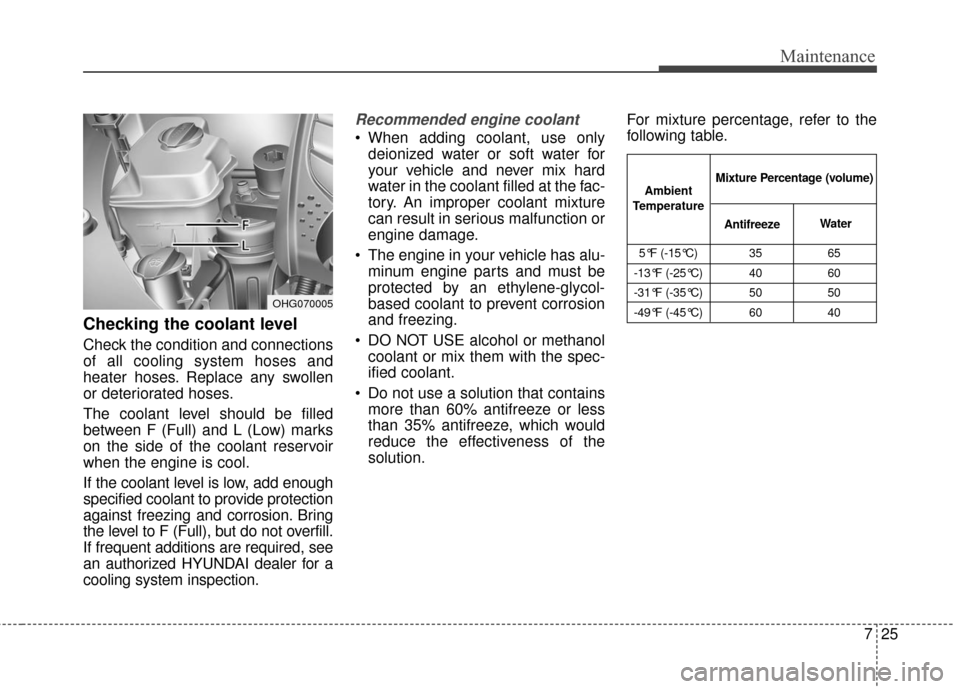
725
Maintenance
Checking the coolant level
Check the condition and connections
of all cooling system hoses and
heater hoses. Replace any swollen
or deteriorated hoses.
The coolant level should be filled
between F (Full) and L (Low) marks
on the side of the coolant reservoir
when the engine is cool.
If the coolant level is low, add enough
specified coolant to provide protection
against freezing and corrosion. Bring
the level to F (Full), but do not overfill.
If frequent additions are required, see
an authorized HYUNDAI dealer for a
cooling system inspection.
Recommended engine coolant
When adding coolant, use onlydeionized water or soft water for
your vehicle and never mix hard
water in the coolant filled at the fac-
tory. An improper coolant mixture
can result in serious malfunction or
engine damage.
The engine in your vehicle has alu- minum engine parts and must be
protected by an ethylene-glycol-
based coolant to prevent corrosion
and freezing.
DO NOT USE alcohol or methanol coolant or mix them with the spec-
ified coolant.
Do not use a solution that contains more than 60% antifreeze or less
than 35% antifreeze, which would
reduce the effectiveness of the
solution. For mixture percentage, refer to the
following table.
OHG070005
5°F (-15°C) 35
65
-13°F (-25°C) 40 60
-31°F (-35°C) 50 50
-49°F (-45°C) 60 40
Ambient
Temperature Mixture Percentage (volume)
Antifreeze Water
Page 442 of 520
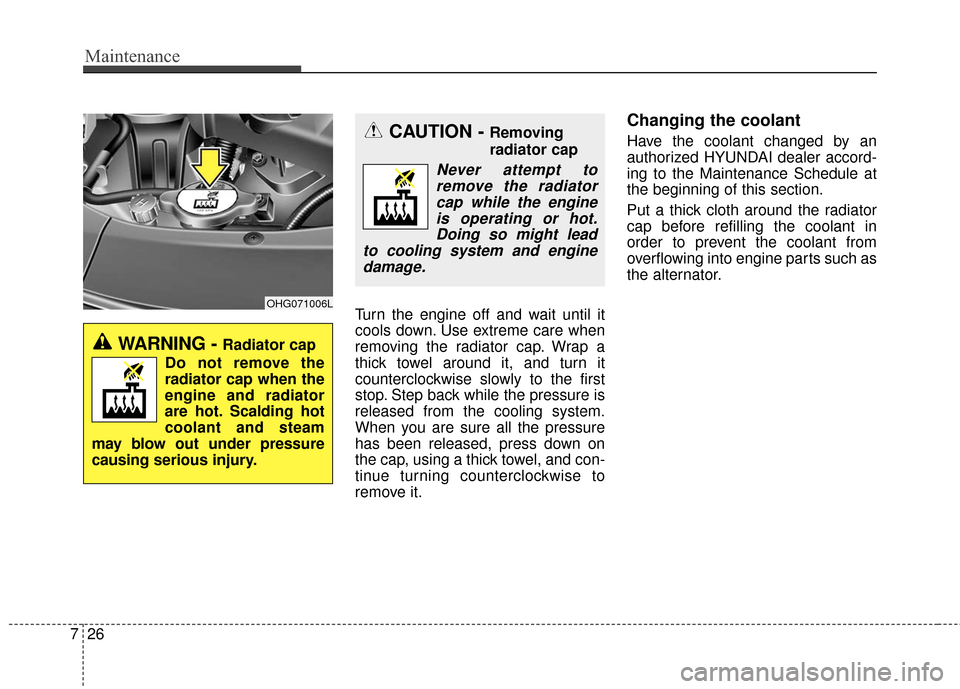
Maintenance
26
7
Turn the engine off and wait until it
cools down. Use extreme care when
removing the radiator cap. Wrap a
thick towel around it, and turn it
counterclockwise slowly to the first
stop. Step back while the pressure is
released from the cooling system.
When you are sure all the pressure
has been released, press down on
the cap, using a thick towel, and con-
tinue turning counterclockwise to
remove it.
Changing the coolant
Have the coolant changed by an
authorized HYUNDAI dealer accord-
ing to the Maintenance Schedule at
the beginning of this section.
Put a thick cloth around the radiator
cap before refilling the coolant in
order to prevent the coolant from
overflowing into engine parts such as
the alternator.
WARNING - Radiator cap
Do not remove the
radiator cap when the
engine and radiator
are hot. Scalding hot
coolant and steam
may blow out under pressure
causing serious injury.
OHG071006L
CAUTION - Removing
radiator cap
Never attempt to remove the radiator cap while the engineis operating or hot.Doing so might lead
to cooling system and engine damage.
Page 443 of 520
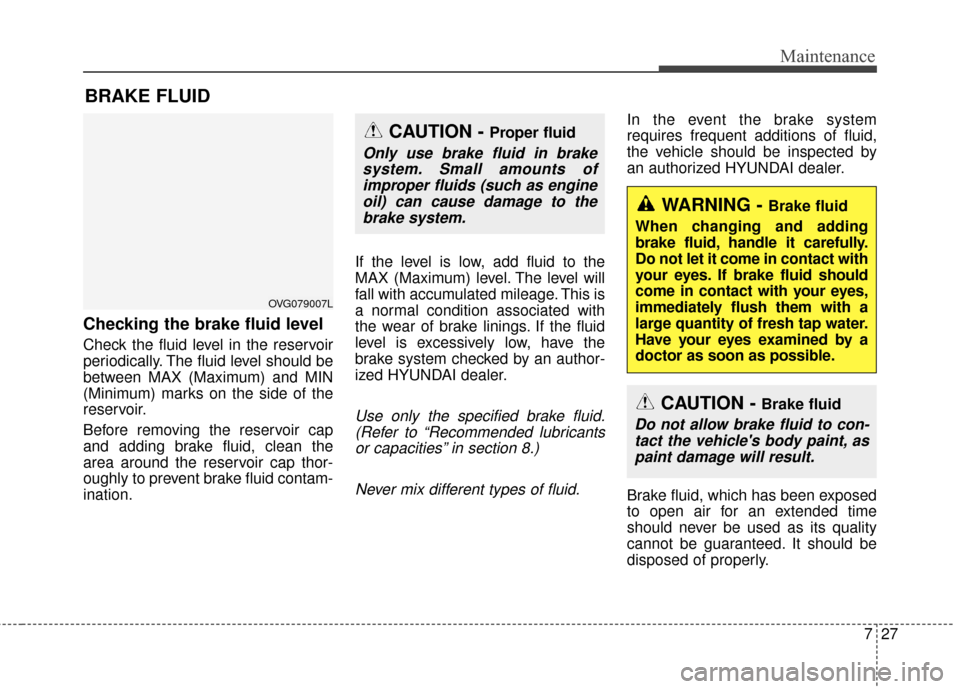
727
Maintenance
BRAKE FLUID
Checking the brake fluid level
Check the fluid level in the reservoir
periodically. The fluid level should be
between MAX (Maximum) and MIN
(Minimum) marks on the side of the
reservoir.
Before removing the reservoir cap
and adding brake fluid, clean the
area around the reservoir cap thor-
oughly to prevent brake fluid contam-
ination.If the level is low, add fluid to the
MAX (Maximum) level. The level will
fall with accumulated mileage. This is
a normal condition associated with
the wear of brake linings. If the fluid
level is excessively low, have the
brake system checked by an author-
ized HYUNDAI dealer.
Use only the specified brake fluid.
(Refer to “Recommended lubricantsor capacities” in section 8.)
Never mix different types of fluid.
In the event the brake system
requires frequent additions of fluid,
the vehicle should be inspected by
an authorized HYUNDAI dealer.
Brake fluid, which has been exposed
to open air for an extended time
should never be used as its quality
cannot be guaranteed. It should be
disposed of properly.
OVG079007L
CAUTION - Proper fluid
Only use brake fluid in brakesystem. Small amounts ofimproper fluids (such as engineoil) can cause damage to thebrake system.
CAUTION - Brake fluid
Do not allow brake fluid to con-tact the vehicle's body paint, aspaint damage will result.
WARNING - Brake fluid
When changing and adding
brake fluid, handle it carefully.
Do not let it come in contact with
your eyes. If brake fluid should
come in contact with your eyes,
immediately flush them with a
large quantity of fresh tap water.
Have your eyes examined by a
doctor as soon as possible.
Page 444 of 520
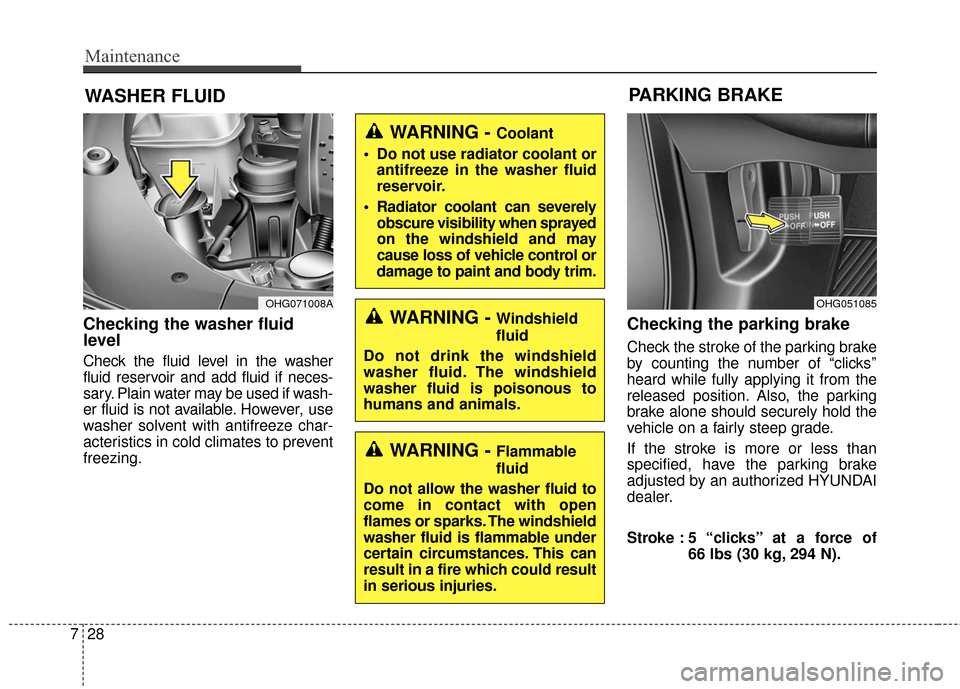
Maintenance
28
7
WASHER FLUID
Checking the washer fluid
level
Check the fluid level in the washer
fluid reservoir and add fluid if neces-
sary. Plain water may be used if wash-
er fluid is not available. However, use
washer solvent with antifreeze char-
acteristics in cold climates to prevent
freezing.
Checking the parking brake
Check the stroke of the parking brake
by counting the number of “clicks’’
heard while fully applying it from the
released position. Also, the parking
brake alone should securely hold the
vehicle on a fairly steep grade.
If the stroke is more or less than
specified, have the parking brake
adjusted by an authorized HYUNDAI
dealer.
Stroke : 5 “clicks’’ at a force of
66 lbs (30 kg, 294 N).
OHG071008AOHG051085
PARKING BRAKE
WARNING - Windshield
fluid
Do not drink the windshield
washer fluid. The windshield
washer fluid is poisonous to
humans and animals.
WARNING - Coolant
Do not use radiator coolant or antifreeze in the washer fluid
reservoir.
Radiator coolant can severely obscure visibility when sprayed
on the windshield and may
cause loss of vehicle control or
damage to paint and body trim.
WARNING - Flammable
fluid
Do not allow the washer fluid to
come in contact with open
flames or sparks. The windshield
washer fluid is flammable under
certain circumstances. This can
result in a fire which could result
in serious injuries.
Page 445 of 520
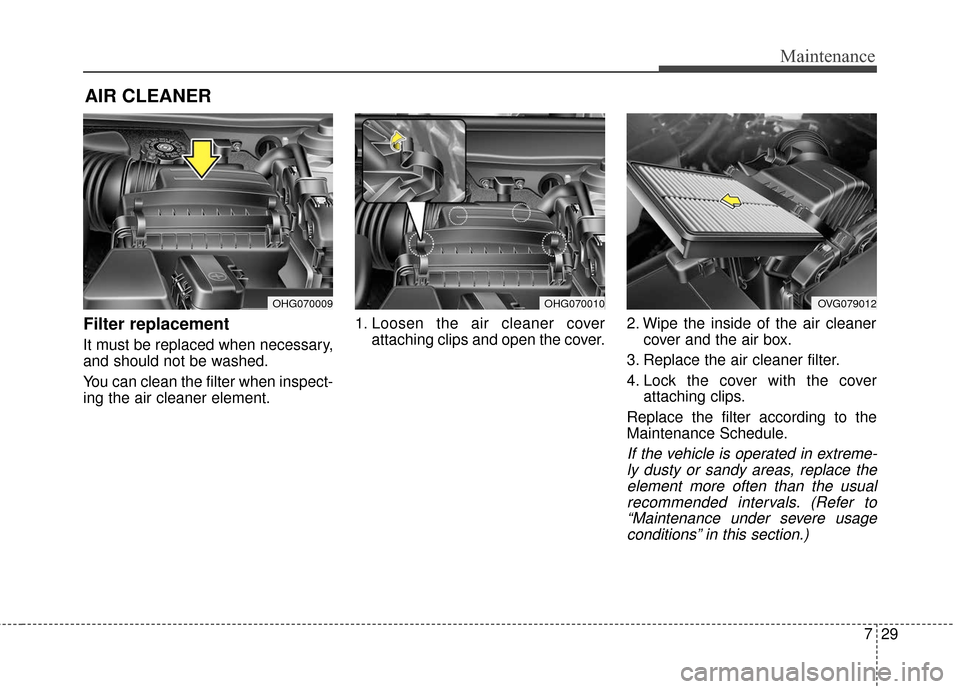
729
Maintenance
AIR CLEANER
Filter replacement
It must be replaced when necessary,
and should not be washed.
You can clean the filter when inspect-
ing the air cleaner element.1. Loosen the air cleaner cover
attaching clips and open the cover. 2. Wipe the inside of the air cleaner
cover and the air box.
3. Replace the air cleaner filter.
4. Lock the cover with the cover attaching clips.
Replace the filter according to the
Maintenance Schedule.
If the vehicle is operated in extreme- ly dusty or sandy areas, replace the element more often than the usual recommended intervals. (Refer to“Maintenance under severe usageconditions” in this section.)
OHG070009OHG070010OVG079012
Page 446 of 520
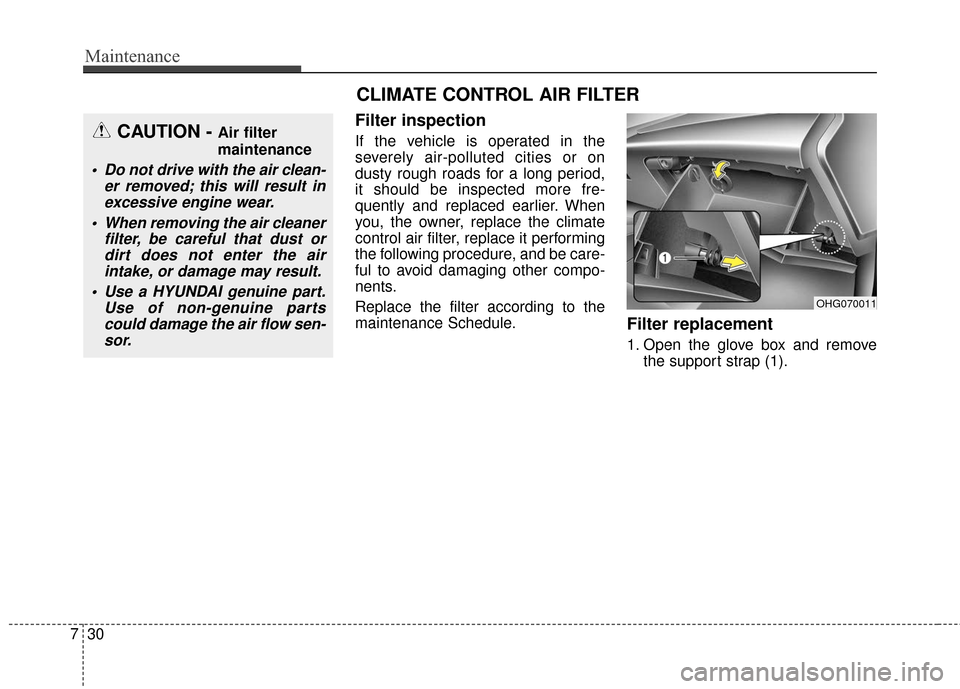
Maintenance
30
7
Filter inspection
If the vehicle is operated in the
severely air-polluted cities or on
dusty rough roads for a long period,
it should be inspected more fre-
quently and replaced earlier. When
you, the owner, replace the climate
control air filter, replace it performing
the following procedure, and be care-
ful to avoid damaging other compo-
nents.
Replace the filter according to the
maintenance Schedule.
Filter replacement
1. Open the glove box and remove
the support strap (1).
CAUTION - Air filter
maintenance
Do not drive with the air clean-er removed; this will result inexcessive engine wear.
When removing the air cleaner filter, be careful that dust ordirt does not enter the airintake, or damage may result.
Use a HYUNDAI genuine part. Use of non-genuine partscould damage the air flow sen-sor.
CLIMATE CONTROL AIR FILTER
OHG070011
Page 447 of 520
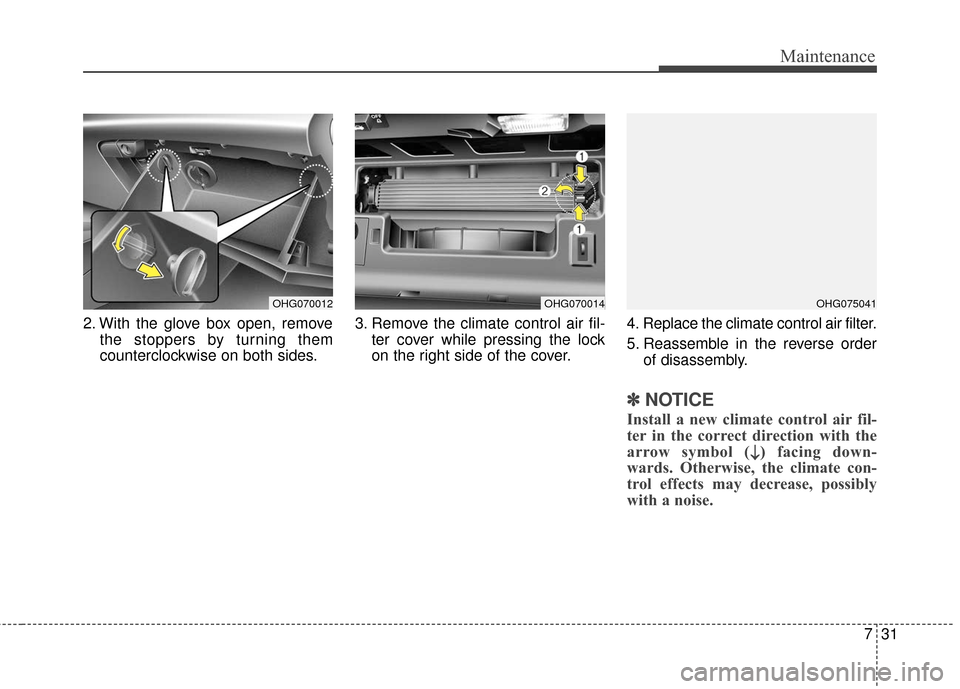
731
Maintenance
2. With the glove box open, removethe stoppers by turning them
counterclockwise on both sides. 3. Remove the climate control air fil-
ter cover while pressing the lock
on the right side of the cover. 4. Replace the climate control air filter.
5. Reassemble in the reverse order
of disassembly.
✽ ✽NOTICE
Install a new climate control air fil-
ter in the correct direction with the
arrow symbol (
↓ ↓) facing down-
wards. Otherwise, the climate con-
trol effects may decrease, possibly
with a noise.
OHG070012OHG075041OHG070014
Page 448 of 520
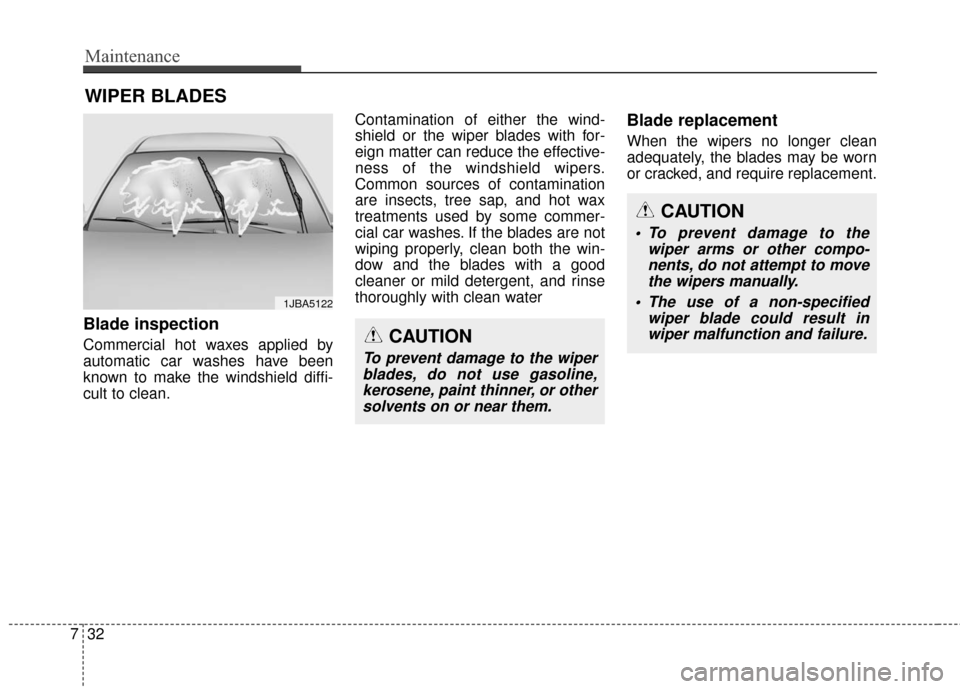
Maintenance
32
7
WIPER BLADES
Blade inspection
Commercial hot waxes applied by
automatic car washes have been
known to make the windshield diffi-
cult to clean. Contamination of either the wind-
shield or the wiper blades with for-
eign matter can reduce the effective-
ness of the windshield wipers.
Common sources of contamination
are insects, tree sap, and hot wax
treatments used by some commer-
cial car washes. If the blades are not
wiping properly, clean both the win-
dow and the blades with a good
cleaner or mild detergent, and rinse
thoroughly with clean water
Blade replacement
When the wipers no longer clean
adequately, the blades may be worn
or cracked, and require replacement.
1JBA5122
CAUTION
To prevent damage to the wiper
blades, do not use gasoline,kerosene, paint thinner, or othersolvents on or near them.
CAUTION
To prevent damage to the wiper arms or other compo-nents, do not attempt to movethe wipers manually.
The use of a non-specified wiper blade could result inwiper malfunction and failure.
Page 449 of 520
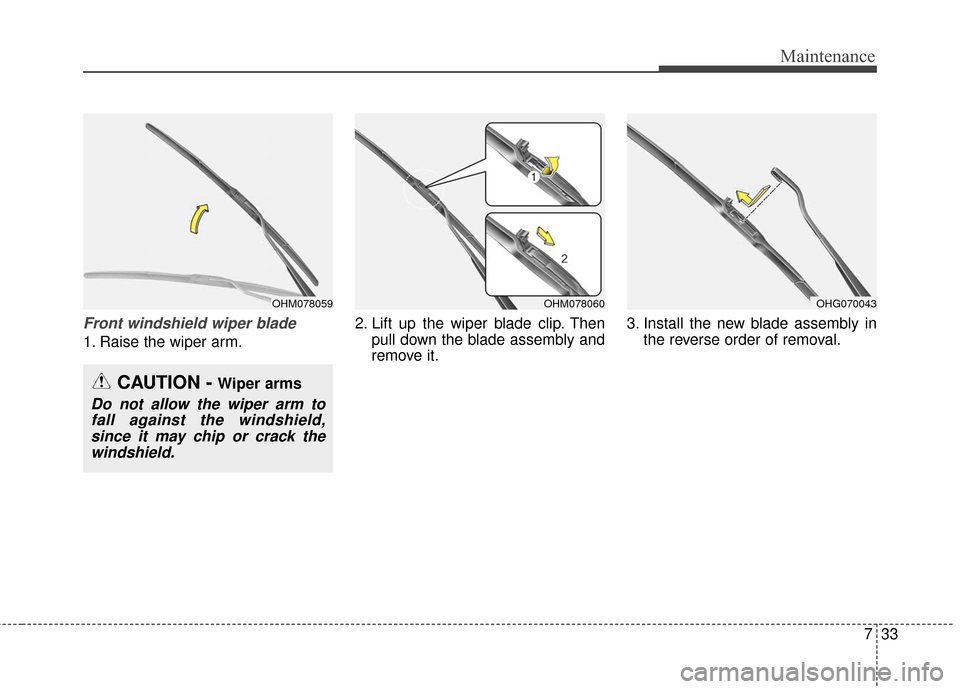
733
Maintenance
Front windshield wiper blade
1. Raise the wiper arm.2. Lift up the wiper blade clip. Then
pull down the blade assembly and
remove it. 3. Install the new blade assembly in
the reverse order of removal.
OHM078059OHM078060OHG070043
CAUTION - Wiper arms
Do not allow the wiper arm tofall against the windshield,since it may chip or crack thewindshield.
Page 450 of 520
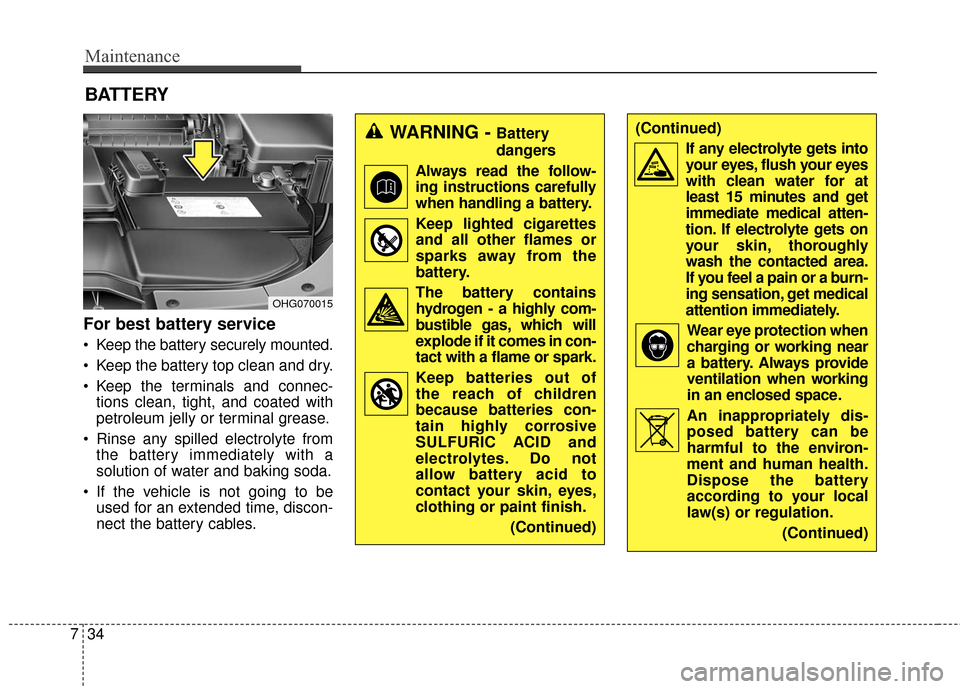
Maintenance
34
7
For best battery service
Keep the battery securely mounted.
Keep the battery top clean and dry.
Keep the terminals and connec-
tions clean, tight, and coated with
petroleum jelly or terminal grease.
Rinse any spilled electrolyte from the battery immediately with a
solution of water and baking soda.
If the vehicle is not going to be used for an extended time, discon-
nect the battery cables.
BATTERY
OHG070015
WARNING - Battery
dangers
Always read the follow- ing instructions carefully
when handling a battery.
Keep lighted cigarettes and all other flames or
sparks away from the
battery.
The battery contains hydrogen - a highly com-
bustible gas, which will
explode if it comes in con-
tact with a flame or spark.
Keep batteries out of the reach of children
because batteries con-
tain highly corrosive
SULFURIC ACID and
electrolytes. Do not
allow battery acid to
contact your skin, eyes,
clothing or paint finish.
(Continued)(Continued)If any electrolyte gets intoyour eyes, flush your eyes
with clean water for at
least 15 minutes and get
immediate medical atten-
tion. If electrolyte gets on
your skin, thoroughly
wash the contacted area.
If you feel a pain or a burn-
ing sensation, get medical
attention immediately.
Wear eye protection whencharging or working near
a battery. Always provide
ventilation when working
in an enclosed space.
An inappropriately dis- posed battery can be
harmful to the environ-
ment and human health.
Dispose the battery
according to your local
law(s) or regulation.
(Continued)